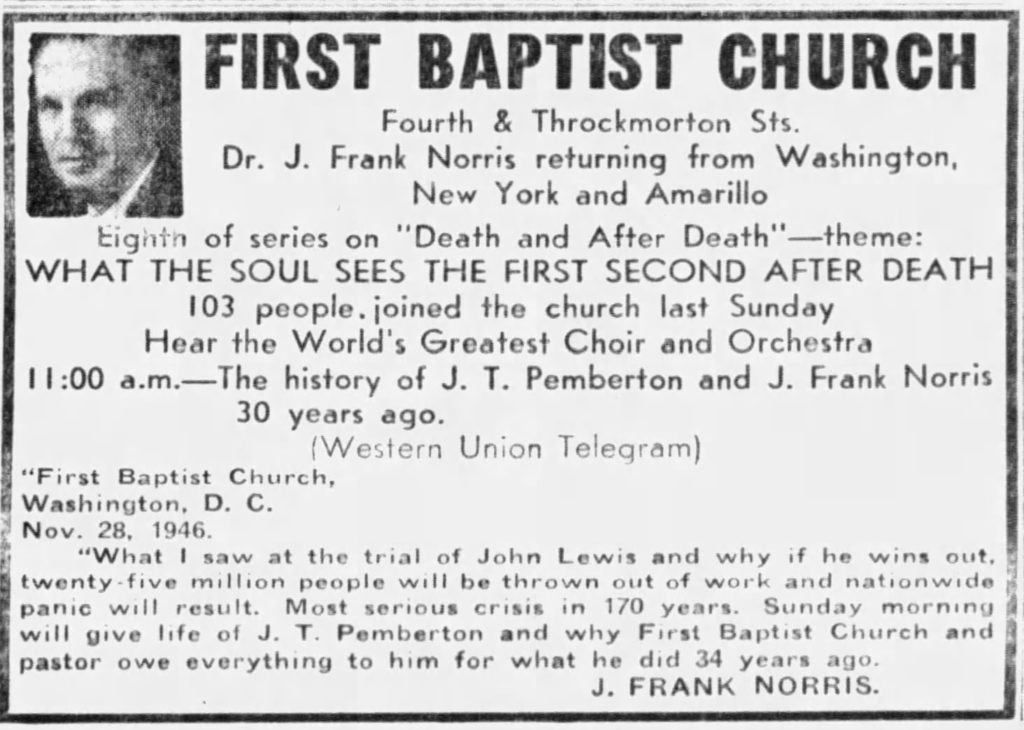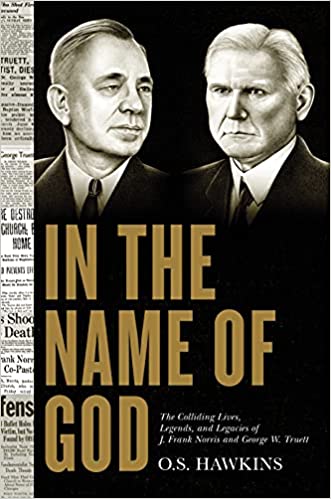I heard months ago from Raymond Barber that O.S. Hawkins was writing a book on Norris and Truett. I was very excited to hear that since Hawkins had written an article about Norris and Southwestern Baptist Theological Seminary. To hear someone within the SBC take a objective view on Norris’s ministry is quite rare.
In the Name of God: The Colliding Lives, Legends, and Legacies of J. Frank Norris and George W. Truett is published by B&H Academic. It is 213 pages long, with 152 of those being the text and the rest endnotes, bibliography, etc. List price is $29.99.
Before I begin my review, I want to acknowledge that this very website is cited as a source (see pages 64, 164, and 206) – which is so exciting for me! Having studied, collected, and written about Norris off and on for 15+ years there is a sense of vindication when you see your work cited in print. Even if it was just a reference to membership number at the First Baptist in Fort Worth which I had compiled from various sources and not something really original it still excites me. So much more so than the time this site was cited on Wikipedia. Anyway, I will note that the particular page that is referenced is not currently available. I did not put it back up after I switched over to WordPress. Guess I need to fix that.
In the annals of Southern Baptists, the name of Truett has been revered and the name of Norris reviled. Hawkins’s objective approach in this book is that there is a much more balanced view that needs to be taken of the two. The two men are so easily compared and contrasted – they ministered some 30 miles apart, their paths intersected often, they were both leading pulpiteers, they both led in building some of the earliest megachurches, and so on. This is not the first work on the subject, nor will it be the last.
Hawkins does spend far more space dealing with Norris than Truett. That is because the main thrust of this book, though many will argue and refuse to acknowledge it, is that Norris’s impact on the SBC today is greater than Truett’s. Chapter 5 – “The Influence of J. Frank Norris on Modern Southern Baptist Theology, Church Growth, Evangelism, and Practice” is the best in the book. The previous chapters are largely background for this analysis. The Baptist historian Leon McBeth had written that Norris “had no constructive part in Southern Baptist ministries in this century.” Hawkins takes him to task, even calling out that statement five times with clear examples of its error.
Hawkins is clear that the ministry and personality Norris are complex. He does not paint him as a hero nor a villain. He is objective and analytical in his approach. But he shows that Norris was right on many issues, which is difficult to find SBC writers to acknowledge. Norris’s tactics and combativeness have distracted many from seeing that in so many ways he was right.
Some points of controversy are finally addressed, such as whether Norris was valedictorian at Louisville and if Norris gave rotting fruit to SBTS staff. I will say that Hawkins does take the word of Norris and Entzminger with less skepticism than I would expect since they can embellish things a bit.
I will say that I find the writing to be uneven. Sometimes it sounds very much like a sermon with elaborate and unnecessary alliteration. A couple of sentences I honestly had to reread a few times because they felt incomplete. It is not academic or dry by any stretch. Overall an enjoyable read.
The book is well sourced (and I am not saying that because my website is referenced). However, I get the feeling that not everything in the lengthy bibliography was actually referenced in the making of this book. I cannot prove that statement, just a hunch. I compared it to my own Norris bibliography that I have been working on in an attempt to compile an exhaustive list of resources and especially Norris’s publications. Many of these books and pamphlets are extremely hard to find. It took me years to find copies of some of them. So many of them I have never been able to locate copies of and I simply have recorded their reported existence. Yet I find all but a handful listed in Hawkins’s bibliography regardless of their relevance to the subject. Perhaps he is, like me, merely acknowledging the existence of the works. I sincerely doubt he has actually referenced them all.
There are some finer points that he does get wrong. Speaking of Norris heading to Baylor University on p. 23, Hawkins writes: “No evidence exists to show how he acquired the resources for this journey and his initial college expenses…”. However, Ray Tatum (whom Hawkins references multiple times) wrote: “…Frank presented himself in the small office of the family doctor, W.A. Woods, and told him, with confidence, of his aspirations to attend Baylor University. He asked the doctor for a loan of one hundred dollars, and received ‘one hundred and fifty.'” (Conquest or Failure?, p. 42, with a citation from a 1945 article in The Fundamentalist)
Another example that Hawkins either missed or simplified is that impact of Louis Entzminger on Norris’s ministry. He credits Norris with influencing Arthur Flake’s Sunday School system (p. 111-113). It was not Norris that invented that system, but Louis Entzminger who arrived in Fort Worth in 1913 to build that Sunday School system. Entzminger is also the man who convinced Norris to adopt Premillennialism.
Some other things he is wrong on or curious:
- Repeats the unfounded rumor that Norris killed his father-in-law (p. 27). The endnote highlights the suspicious nature of the accusation.
- J.T. Pemberton’s name is misspelled as Pemperton repeatedly (p. 27 and so on).
- Attributing “multisite campuses” to Norris (p. 110, 136). Norris had to be creative in finding places to meet or to hold the crowds but these were never satellites of his churches – they were the same church meeting in different places.
- Saying that Norris “wrote” commentaries (p. 129). These were lectures he gave so writing may be a stretch.

I also would like to take issue with a couple of statements made about Norris’s legacy. On page 144: “In the end, much of what Norris stood for diminished. His network of churches was repeatedly divided across the decades and is virtually unnoticeable today.” [emphasis added]. Splintered, yes. Unnoticeable? Only to those who do not look. Strong SBC bias against Independent Baptists there.
Also I would like to take issue with the statement in the end notes on page 160: “The remnants of Norris’s seminary still exist today…” [emphasis added]. Remnants? That is a loaded word and surely a better one could have been used.
I suppose we can give Hawkins a pass on some of this. He is many things but a professional historian is not one.
Lest you think otherwise, I do really like this book. Hawkins’s approach and perspective is a welcome one.
I like what Hawkins brings out when he compares Norris and Truett. Norris was for “doctrinal fidelity” and Truett for “denominational loyalty”. Norris reveled in conflict, while Truett stayed aloof from it. Norris preached with passion and animation, Truett with precision and dignity.
There is little new ground covered in chapters 1 through 4. We have brief histories of Dallas and Fort Worth, biographies of Norris and Truett, and synopsis of their conflicts and interactions. You will readily find better and deeper resources for the material, except maybe the presentation of the information in chapter 4. Chapter 5 is, again, the best in the book and a welcome addition to catalog of Norris research available. That chapter could only be written in today’s time with the perspective gained over the decades.
I was very glad to see the relationship between Norris and B.H. Carroll emphasized. Too little study has been done on it.
I absolutely love this perspective on page 148: “The fact that the church [First Baptist of Fort Worth] did, indeed, fragment after his death proved to be a blessing to many sister churches as Bible-believing men and women dispersed to find their places in the local churches of their city, thereby multiplying the ministry and lasting influence of J. Frank Norris many times over.” So true. The fragmentation of the Norris empire did not weaken it, instead it multiplied it.
Final verdict: Despite my nitpicking, this is a worthy and welcome addition to anyone’s library with interest on the SBC or Norris. I think the list price of $29.99 is far too steep so maybe everyone should wait for used copies to become available.
